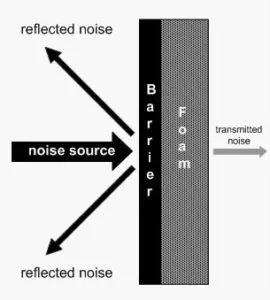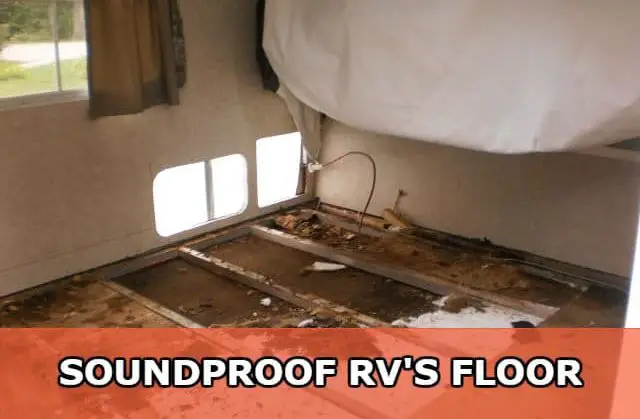Do you ever go camping and wonder what sleep and relaxation would be like without the sound coming from under the RV or van while on the road? Or maybe you live in one of these vehicles, and then this is going to be even more necessary.
I’ve been in this situation. What am I talking about? I’m talking about soundproofing your van’s floor, one of the most worthy investments that you could ever make. That is why in this article I’m going to present to you how to soundproof your van’s or RV’s floor.
What options do you have?
Depending on your budget, you do have some different options to do this. I highly suggest you use quality materials. Although it is going to be a little more expensive, it is worth it. Why? Because it is not as bad as you think. Don’t forget that you are only soundproofing your floor, not your whole van. You don’t need a large amount of material.
The first option would be to lay some carpets on the floor. While this might not be that effective, you still will feel a little difference. Any layer counts when we talk about blocking sounds. This also will make your vehicle more comfortable and give you that welcoming homey vibe.
Make sure you don’t let it get too dirty. Removing all the furniture just to clean the carpets will be a total nightmare. The downside of this method is that you can’t put carpets in front of the car, like above the gearbox, that can give you a lot of noise problems.
For another idea, you can use a very popular material called mass loaded vinyl (MLV). It is used in a lot in arenas and can be a great material for this work. You can buy a big roll for $130. I know, it’s not cheap, but you can use it in other situations. You never know when you need it.
In my opinion, it is worth every penny. I will leave a link for it in case you decide this is the option for you. (https://www.acoustimac.com/soundproofing-massloaded-vinyl-mlv1lb100sf)
Layering 2 materials
The next more effective method would be to layer up 2 materials. That will make your ears a lot happier. The materials to use are a layer of closed-cell foam and a layer of a dense sound barrier. The first one will help insulate the floor while keeping the profile low to allow ply and side steps to be refitted.
The best option for this is going to be the Dodo Super Liner pack because usually 6sq.m of it will do the job for a big van floor. I will also present this material just to make sure you know where your money is going.
The second layer that needs to be applied for maximum effectiveness is a dense sound barrier. This will reduce tire, road, and exhaust noises. I also have a recommendation for this.
The Tecsound Van Flooring Barrier roll has a high density and mass but is extremely pliable. You can apply this even without the previous layer, but, for a better result, you should take my advice for double layering, and you will not regret it. Again, I suggest you buy the 6sq.m just to make sure you don’t run out of it before finishing the job.
If you really feel like going pro with this and have the money to spend, you may try some foam barriers. Not just any though, my suggestion is to go with the Quiet Barrier HD Soundproofing composite. You can find this on almost any website that has soundproof in their name. Just look, and you should be convinced by now.
If you still aren’t, I will describe this and give some install instruction later. You can find this here for about $320. I know, I know. $320 for a sound barrier? Yes, but you get what you pay for. This method is for every demanding human out there that wants a really silent van.
About the materials
What makes MLV a sound blocker material? Its main elements are vinyl and a high mass element that gives the material enough density and acts as a sound barrier. It is very easy to maneuver because it can tear with little effort.
You don’t need any cutting tools or machines. As long as you don’t care how it looks on the floor, you are good to go. Make sure you use some extra layers on the gearbox in order to block the powerful noise.
The Dodo Super Liner is a self-adhesive flexible foam liner that is specially made for sound insulation and vehicle heat. It is also very thin. At only 6mm, it is going to give you amazing results. It can maintain shape under pressure yet be flexible enough to trim easily in many areas of the vehicle.
On top of that, it comes with some very useful standards being resistant to high temperatures, flames, and water. It also has some good reviews, all that for about $80. The link to it.
The Tecsound Van Flooring Barrier has some benefits of giving you high acoustic insulation, and it is soft and very flexible. Also, it provides high sound damping capacity on metal surfaces, and it is easy to handle and adaptable to uneven surfaces. Unlike the MLV, you are going to need a knife or scissors in order to cut it.
It is safe as well. It is cold, heat, rot, and fire-resistant. The price is going to scare you a little, at about $180. Those 2 combined equal $260, but you will definitely forget about loud noises. (source)
The Quiet Barrier HD is a very thin and flexible composite that is guaranteed to fit anywhere if cut well. This will eliminate any medium to even loud noise that your van usually gets when on the road. If you need a thick, strong, and very effective soundproofing material, you just found it. You can compare this to any other material, and you will notice why you paid $320 for it.
How does Quiet Barrier HD work and how to install it?

Although it is a very simple procedure, don’t be alarmed, it will give you the wanted results. The composite blocks the noise from one area to the next, like in the next image
As you can see, the noise source will hit the barrier and return to the space of origin. It will not absorb the sound and give you a lower decibel level, but, instead, it will reflect the noise.
To install, you are going to need a utility knife, tape measure, caulking gun, and a pencil.
- Measure your van and all the parts you need to cover with the tape measure.
- Use the pencil and mark the material. Cut in so the pieces fit the parts you measure in the first step.
- Mark lines around the perimeter of the surface where each piece is supposed to fall based on your layout.
- After the material has been laid out, glue each piece individually using PL Polyurethane Construction Adhesive.
- After panels are installed, seal the seams where the pieces meet using the caulking gun.
And that’s it! Although the sound will not be completely blocked, this is the best you can get. You should be the one to decide if that much money is worth it.
Why should you soundproof your vehicle?
The number one reason why most people do this is, of course, because of the very annoying noises. Also, it improves the sound quality inside the cabin. However, you should know from the beginning that you can’t eliminate all sound. You can’t even do that to a basement, which is not mobile, so it is basically impossible to soundproof an RV.
If you do want some great results, you should consider soundproofing your whole van. Noise sources on a vehicle usually come from the hood, gearbox, panels, floor, license plates, and/or tail lights. However, the floor usually will produce the most noise because it is very close to the road. That is why it isn’t worth investing in soundproofing your whole van if you want just some basic results.
You can also get 2 in 1 service doing this. Obviously, soundproofing implies adding some materials that will reduce the noise you will hear inside the car. These materials also block some of the cold air drawn up from under the van. So not only you will get better acoustics in the car, you will save gas as well by not using as much heat.
Conclusion
Overall, there are plenty of methods for different prices you can choose from, depending on how effective you want it to be. My advice is to go for a medium-priced material because it will do its job. It might be not as good as a premium composite, but you will feel the difference.
You don’t have to spend hundreds of dollars unless you live in one of those vehicles. Now, I want to hear your opinion as well. What method did you choose and how effective it was? How did you think about it?
